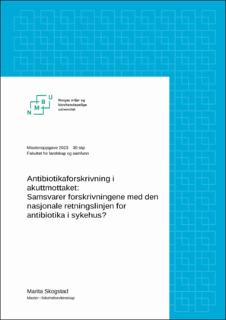| dc.contributor.advisor | Marte Karoline Råberg Kjøllesdal (NMBU) | |
| dc.contributor.advisor | Silje Bakken Jørgensen (Ahus) | |
| dc.contributor.advisor | Heidi Johanne Espvik (Ahus) | |
| dc.contributor.author | Skogstad, Marita | |
| dc.date.accessioned | 2024-04-10T16:27:47Z | |
| dc.date.available | 2024-04-10T16:27:47Z | |
| dc.date.issued | 2023 | |
| dc.identifier | no.nmbu:wiseflow:6985758:56818939 | |
| dc.identifier.uri | https://hdl.handle.net/11250/3125897 | |
| dc.description.abstract | Bakgrunn: Antibiotika er en veldig viktig del av den moderne medisinen, men antibiotikaresistens er et økende problem globalt. Antibiotikaresistens er assosiert med overforbruk og feilbruk av antibiotika. Helsedirektoratets nasjonale retningslinje for antibiotika i sykehus skal bidra til optimal antibiotikabruk.
Formål: Undersøke i hvilken grad antibiotikaforskrivningen i akuttmottaket i et av Norges største akuttsykehus samsvarer med retningslinjen for antibiotika i sykehus.
Metode: Denne kvantitative retrospektive tverrsnittstudien inkluderte 100 antibiotikaforskrivninger fra akuttmottaket på et stort norsk sykehus i perioden april-mai 2022. Forskrivningene og pasientene ble identifisert gjennom datauttrekk fra elektronisk forskrivning ved hjelp av en lokal «Antibiotika app» og kategorisert etter grad av samsvar med den nasjonale retningslinjen med utgangspunkt i journalopplysninger og innleggelsesdiagnosen. Deskriptiv statistikk inkludert krysstabeller ble brukt for pasientkarakteristikker, diagnosegrupper som fikk antibiotika som ikke samsvarte med retningslinjen og antibiotikatyper hyppigst gitt i gruppene som ikke samsvarte med retningslinjen. SPSS ble brukt til å utføre kjikvadrat-test for å undersøke sammenhengen mellom samsvar med retningslinjen og aldersjustert Charlson score og alder alene.
Resultat: Av 100 antibiotikaforskrivninger samsvarte 61 % med retningslinjen, mens 36 % ikke samsvarte grunnet unødvendig bredspektret behandling eller andre feil. De resterende 3 % av forskrivningene var ikke mulig å vurdere. Det var ingen signifikant assosiasjon mellom samsvar med retningslinjen og aldersjustert Charlson score eller alder alene. Diagnosegruppene «sepsis, inkludert intravaskulære infeksjoner», «nedre luftveisinfeksjon» og «øvre urinveisinfeksjon» fikk oftest foreskrevet antibiotika ikke i samsvar med retningslinjen. Cefotaxim var antibiotikatypen som hyppigst ble forskrevet og hyppigst ikke var i samsvar med retningslinjen.
Konklusjon: En vesentlig andel av antibiotikaforskrivningene i denne studien samsvarte ikke med retningslinjen og ligner funn fra andre studier i Norge. Det ser ut til at det finnes rom for forbedring. Denne studiens funn bør danne grunnlag for videre studier for å finne målgrupper antibiotikastyringsarbeidet i sykehuset bør rette seg mot. | |
| dc.description.abstract | Background: The use of antibiotics is a cornerstone in today’s medicine, but antibiotic resistance is an increasing threat to this advancement in modern medicine globally. Antibiotic resistance is associated with the over- and misuse of antibiotics. The Norwegian Directorate of Health´s national guideline for antibiotics in hospitals aims to facilitate prudent use of antibiotics.
Objective: To investigate how antibiotic prescriptions in the Emergency care department in a large Norwegian hospital comply with the national guideline for antibiotics in hospitals.
Methods: This quantitative, retrospective cross-sectional study included 100 antibiotic prescriptions from April-May of 2022 from the Emergency care department of a large Norwegian hospital. Antibiotic prescriptions and patients were identified through data extraction from electronic prescription records by use of a local “Antibiotic app” and categorized according to compliance with the national guideline using medical records, particularly diagnosis on admission as reference. Descriptive statistics, including crosstabulation, were used for patient characteristics, diagnoses associated with receiving antibiotics not compliant with the guideline and antibiotic types associated with the non-compliant prescription groups. Using SPSS, a Chi-square test was performed to investigate the association between guideline compliance and age-adjusted Charlson score and age.
Results: Out of 100 antibiotic prescriptions, 61% were compliant with the guideline and 36% were non-compliant due to unfounded use of broad-spectrum antibiotics or other unfounded reasons. The remaining 3% of prescriptions were not possible to assess. There was no significant association between guideline compliance and age-adjusted Charlson score or age alone. Sepsis including intravascular infections, lower respiratory tract infections and upper urinary tract infections were the diagnoses most commonly prescribed broad-spectrum antibiotics non-compliant with the guideline. The most commonly prescribed antibiotic type which also was most commonly non-compliant with the guideline was cefotaxim.
Conclusion: A substantial share of antibiotic prescriptions did not comply with the guideline in this study, which is similar to other studies in Norway. There seems to be room for improvement. This study´s findings should serve as a foundation for more in-depth investigations of targets for antibiotic stewardship efforts in the hospital. | |
| dc.language | nob | |
| dc.publisher | Norwegian University of Life Sciences | |
| dc.title | Antibiotikaforskrivning i akuttmottaket: Samsvarer forskrivningene med den nasjonale retningslinjen for antibiotika i sykehus? | |
| dc.type | Master thesis | |
